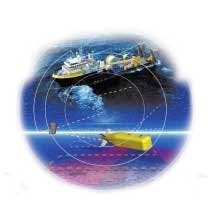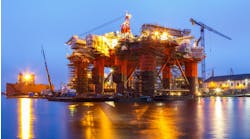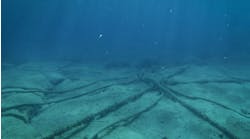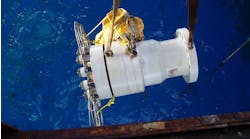Until recently, skeptics called autonomous underwater vehicles (AUV) by a different name. To the remotely operated vehicle (ROV) contracting industry, AUV was a euphemism for a lost vehicle. The idea of programming a $1 million piece of equipment, then turning it loose in the open ocean without an umbilical, runs counter to the entire ROV culture, says Richard Blindberg, Director of the Autonomous Undersea Systems Institute.
While the key to recent advancements in AUV technology is the vehicle's ability to act independently, ROVs are judged in part by how much control the operators at the surface can maintain over them. Blindberg points out that a true AUV is out of its operator's control, and that makes a lot of people nervous.
Pilot or programmer
Where an ROV relies on the skills of its surface pilot to complete complex underwater activities, the AUV relies solely on high level programming and orientation technology. Until several years ago, this technology was not yet ready for commercial application. AUVs rapidly improved over the past two years in their ability to gather remote data and navigate back to the host vessel. Now, it appears that everyone's AUV units are hitting the market at the same time.
There are at least seven distinct AUV commercial projects that either have vehicles in service or are on a fast track to offer them in the next few months. This surge in activity has been driven by the need of commercial companies to operate in deeper water. Robust autonomous software will be the key discriminator between competing companies, according to Tom Jones, Project Manager for Boeing's Ocean Systems Department. Boeing recently formed a partnership with Oceaneering and Fugro to build, outfit, and operate an AUV for commercial applications.
Boeing will handle the AUV design, guidance, and control systems, including critical software. It is the guidance software Jones credits for AUV commercialization. With the new developments, a unit can be relied on to map the seabed, maintain a constant distance from the seafloor, and avoid hazards. Pat Matthews with Oceaneering says this software allows the vehicle to interpret its surroundings and avoid getting into situations where it could become trapped.
Deep-tow limits
While advances in technology are driving AUVs into the commercial market, the demands of deepwater are pulling AUVs out of the research sector. If successful, early versions of this and other AUVs could replace deep-tow survey methods that are pushing technical limits.
A deep-tow survey requires that a finned metal fish, armed with sensors, be dragged as much as a mile behind a tow vessel. This position allows the fish to remain near the sea bottom during the survey. At such great distances, however, there is considerable drag on the tether, and it is difficult to keep the fish on course and at a constant depth.
Because of the tether length, it is also very difficult to execute a turn with the fish deployed. In extreme cases, this activity would require a second towing vessel.
These are the two major problems AUV makers hope to solve. Attached to these problems are the cost and time of a vessel and its crew. If an AUV could perform such surveys, it could do so in a fraction of the time. It can be programmed to stay a constant distance from the seabed and avoid any obstacles.
The AUVs currently under design can turn in minutes, as opposed to hours for a deep-tow fish, and only require a crew and vessel for the launch and recovery portions of the process. Because they are autonomous, these vehicles can be launched from a variety of hosts including a platform, a vessel of opportunity, or even from the beach.
Deployment flexibility
While a crew would be required to program, launch, recover, and maintain the AUV, it would not be necessary for a dedicated crew and vessel to stay on site at all times. It is possible one boat could operate several such surveys at once, or one survey using a number of AUVs. Because the AUV is self-guided, it easily adapts its depths to the seabed terrain, giving more accurate survey readings. This type of equipment is already in use in areas where it is impractical or impossible to use a survey vessel.
The Autosub research vehicle, developed by Southampton University, recently completed work under ice in Antarctica and will soon be working offshore Greenland, also under the ice shelf. It is being developed by Halliburton for the commercial market. (See related story on page 63) Niel Milne of Halliburton Subsea said his company has been considering moving into this market for a year and a half. Halliburton has decided to sign a licensing agreement with Southampton University giving it access to the Autosub technology. Southampton has had an AUV program in place for six years, counting fish stocks in the North Sea and performing other environmental measurements. The Autosub would be used by Halliburton to perform seabed surveys similar to the work the Boeing vehicle is envisioned to do.
AUV challenge
The biggest challenge in making the shift from an ROV to an AUV is the guidance and control systems, and the algorithms that allow the vehicle to work independently. Boeing has been developing this software since the mid-1970s, Jones said. "We think we have good technology in the one area that is the hardest in making the leap from ROVs to AUVs," he said.
In addition to a reliable means of controlling the vehicle, providing power is another major challenge. The Autosub can run up to 50 hours in its research configuration, but Milne said this time would be cut in half, if there were more demanding commercial sensors installed on the vehicle.
While functions such as survey work and collecting sensor data can be performed using conventional power sources, more intense activities one normally associates with work-class ROVs would require something new.
Boeing has been working with the US Navy on a long-term mine reconnaissance project that requires experience with the chemistry involved in both high and low energy densities. Jones said Boeing is not interested in developing new power sources for this vehicle.
He points out that the automobile electric vehicle market has been expending significant research dollars in this area and the AUV industry should capitalize from these advances. Blindberg said there have been a number of efforts to develop an alternate power source for AUVs that would not only offer more energy, but a sustainable power source.
Chief among the potential energy sources is nuclear power. Aside from the political issues associated with nuclear power, a nuclear reactor seems the ideal power source for an AUV. In fact, Blindberg said, a Canadian manufacturer has actually built one. The only thing blocking the use of this technology is the political repercussions. Along a different route, he said there have also been investigations into the possibility of powering an AUV with a diesel engine.
Boeing will be working with whatever high-energy density chemistries that are available. For the time being, this somewhat limits the capability of the new vehicles. The design being promoted by Boeing, Fugro, and Oceaneering is able to make 8 knots underwater, which while not exactly fast, is twice as powerful as others on the market. Matthews explained that the goal was not to build a faster AUV, but to have a vehicle that could hold course against the strong currents sometimes encountered in deepwater.
Game change
While ROV operators are a very hands-on group, this trend toward AUVs requires a different skill set. More reliant on cutting edge computer technology than horsepower, the AUV development programs may indicate a shift in how underwater tasks are performed.
While the AUV offers something new to users, it also offers a new product for the old-line ROV companies. This could be good news for a market that was shrinking in players. While many developments in AUV technology are coming from outsiders, there is a need to involve traditional ROV providers who have both the practical experience and industry contacts to commercialize these vehicles.
This could introduce new equipment and participation into the industry, and, at the same time, it will boost competition among the existing industry leaders.




